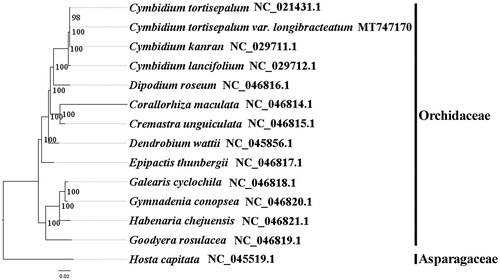Abstract
Cymbidium tortisepalum (Orchidaceae) has been ranked as an endangered (EN) herb species in China. In this study, we report and characterize the complete plastid genome sequence of C. tortisepalum var. longibracteatum in order to provide genomic resources helpful for promoting its conservation and garden utilization. The complete plastome is 150,198 bp in length and contains the typical quadripartite structure of angiosperm, including two Inverted Repeat (IRs) regions of 25,682 bp, a Large Single-Copy (LSC) region of 85,035 bp and a Small Single-Copy (SSC) region of 13,799 bp. The plastome contains 111 genes, consisting of 77 unique protein-coding genes, 30 unique tRNA gene and 4 unique rRNA genes. The overall A/T content in the plastome of C. tortisepalum var. longibracteatum is 62.90%. The complete plastome sequence of C. tortisepalum var. longibracteatum will provide a useful resource for the conservation and garden utilization of this species as well as for the phylogenetic studies of Orchidaceae.
Introduction
Cymbidium tortisepalum var. longibracteatum (Y.S.Wu & S.C.Chen) S.C.Chen & Z.J.Liu is a herb species belonging to Orchidaceae. Leaves are stiff and suberect, 50–70 cm long and 1.2–1.5 cm wide. C. tortisepalum var. longibracteatum is native to Guizhou, Sichuan and Yunnan of China and it grows in rocky and scrubby slopes with altitude from 1000–2000 m (Liu et al. Citation2009). It has been ranked as an endangered (EN) species in China (Qin et al. Citation2017). Consequently, the genetic and genomic information is urgently needed to promote its systematics research and the development of conservation value of C. tortisepalum var. longibracteatum. In this study, the complete plastome of C. tortisepalum var. longibracteatum (GenBank accession number: MT747170) was reported and characterized. This is the first report of a complete plastome for C. tortisepalum var. longibracteatum.
In this study, C. tortisepalum var. longibracteatum was sampled from the greenhouse within Hainan University campus, Haikou, Hainan, China (110.33°E, 20.06°N). A voucher specimen (Wang et al. B260) was deposited in the Herbarium of the Institute of Tropical Agriculture and Forestry (HUTB), Hainan University, Haikou, China.
The experiment procedure is as reported in Zhu et al. (Citation2018). Around six Gb clean data were assembled against the plastome of Cymbidium tortisepalum (NC_021431.1) (Yang et al. Citation2013) using MITObim v1.8 (Hahn et al. Citation2013). The plastome was annotated using Geneious R8.0.2 (Biomatters Ltd., Auckland, New Zealand) against the plastome of C. tortisepalum (NC_021431.1).
The plastome of C. tortisepalum var. longibracteatum is found to possess a total length 150,198 bp with the typical quadripartite structure of angiosperms, contains two Inverted Repeats (IRs) of 25,682 bp, a Large Single-Copy (LSC) region of 85,035 bp and a Small Single-Copy (SSC) region of 13,799 bp. The plastome contains 111 genes, consisting of 77 unique protein-coding genes, 30 unique tRNA genes and 4 unique rRNA genes. The overall A/T content in the plastome of C. tortisepalum var. longibracteatum is 62.90%, which the corresponding value of the LSC, SSC and IR region were 65.50%, 70.30% and 56.50%, respectively.
We used RAxML (Stamatakis Citation2006) with 1000 bootstraps under the GTRGAMMAI substitution model to reconstruct a maximum likelihood (ML) phylogeny of 12 published complete plastomes of Orchidaceae, using Hosta capitata (Asparagaceae) as an outgroup. The phylogenetic analysis indicated that C. tortisepalum var. longibracteatum is close to C. tortisepalum within Orchidaceae in this study (). Most nodes in the plastome ML tree were strongly supported. The complete plastome sequence of C. tortisepalum var. longibracteatum will provide a useful resource for the conservation genetics of this species as well as for the phylogenetic studies of Orchidaceae.
Figure 1. The best ML phylogeny recovered from 14 complete plastome sequences by RAxML. Accession numbers: Cymbidium tortisepalum var. longibracteatum MT747170, Cymbidium tortisepalum NC_021431.1, Cymbidium kanran NC_029711.1, Cymbidium lancifolium NC_029712.1, Dipodium roseum NC_046816.1, Corallorhiza maculata NC_046814.1, Cremastra unguiculata NC_046815.1, Dendrobium wattii NC_045856.1, Epipactis thunbergii NC_046817.1, Galearis cyclochila NC_046818.1, Gymnadenia conopsea NC_046820.1. Habenaria chejuensis NC_046821.1, Goodyera rosulacea NC_046819.1. Outgroups: Hosta capitata NC_045519.1.

Disclosure statement
No potential conflict of interest was reported by the author(s).
Data availability statement
The data that support the findings of this study are openly available in GenBank of NCBI at http://www.ncbi.nlm.nih.gov, reference number MT747170.
Additional information
Funding
References
- Hahn C, Bachmann L, Chevreux B. 2013. Reconstructing mitochondrial genomes directly from genomic next-generation sequencing reads – a baiting and iterative mapping approach. Nucleic Acids Res. 41(13):e129–e129.
- Liu ZJ, Chen XQ, Cribb PJ. 2009. Flora of China. Vol. 25. Beijing: Science Press; p. 260–280.
- Qin H, Yang Y, Dong S, He Q, Jia Y, Zhao L, Yu S, Liu H, Liu B, Yan Y,A, et al. 2017. List of threatened species of higher plants in China. Biodiversity. 25:696–744.
- Stamatakis A. 2006. RAxML-VI-HPC: maximum likelihood-based phylogenetic analyses with thousands of taxa and mixed models. Bioinformatics. 22(21):2688–2690.
- Yang JB, Tang M, Li HT, Zhang ZR, Li DZ. 2013. Complete chloroplast genome of the genus Cymbidium: lights into the species identification, phylogenetic implications and population genetic analyses. BMC Evol Biol. 13:84.
- Zhu ZX, Mu WX, Wang JH, Zhang JR, Zhao KK, Ross Friedman C, Wang H-F. 2018. Complete plastome sequence of Dracaena cambodiana (Asparagaceae): a species considered “Vulnerable” in Southeast Asia. Mitochondrial DNA Part B. 3(2):620–621.
